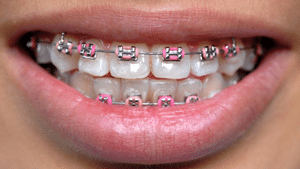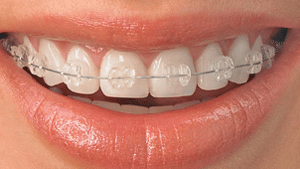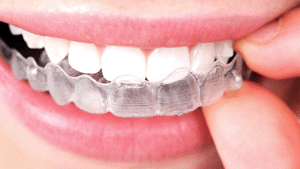Thanks to today’s advances in orthodontic technology, Sorensen Orthodontics can provide our patients with more options when it comes to wearing braces than ever before. While traditional metal braces are still widely used, clear braces are very popular with teens and adults who are self-conscious about wearing braces, along with Invisalign removable aligners, the “braceless” alternative to straight teeth. Dr. Travis A. Sorensen will help you determine which treatment option is right for you.
Metal Braces
Traditional metal braces are the most common type of braces used today. They are smaller and more comfortable than ever before and constructed of high-grade space age metal alloys. With metal braces, you have the option of adding colored elastics (rubber bands) for a more unique and colorful smile.

Ceramic Braces
Ceramic braces are made of clear materials and are therefore less visible on your teeth than metal braces. For this reason, ceramic braces are used mainly on teenage and adult patients who have aesthetic concerns. While they are visually less prominent, they do require more attention to oral hygiene since ceramic braces are larger. The only drawback to ceramic brackets is that they are more fragile and the elastic ties can discolor between orthodontic visits with certain foods and smoking.

Invisible Braces
Clear appliances, such as Invisalign, use a series of invisible, removable, and comfortable aligners to straighten your teeth. No one can tell you are wearing those aligners because they are invisible! Invisalign aligners are removable so you are not limited in what you can eat and drink during treatment. Plus… brushing and flossing are less of a hassle. The aligners are comfortable and have no metal to cause mouth abrasions during treatment. 
GAC Mystique
Mystique offers the subtlety of a retainer with the strength of metal braces. While remarkably translucent, they’re impossible to discolor. They go on easily and are removed just like ordinary metal appliances. They’re ultra-smooth, providing excellent sliding mechanics and yet are as strong as metal-slot appliances.
Herbst®
One of the most common problems orthodontists treat is the discrepancy that occurs when the upper teeth protrude beyond the lower. Ordinarily, when we see a patient with the upper teeth protruding, we tend to think that the upper jaw and teeth are too far forward; but, more often than not, this condition is due to a small lower jaw that is further back than it should be. With these patients, we would like to encourage the lower jaw to catch up in growth, and braces like the Herbst appliance help this happen.
Even though the Herbst appliance prevents the lower jaw from moving backward, opening and closing movement still occur easily, and patients do not have any problems learning to chew their food with their lower jaw in this new position.
As with all kinds of braces, patients with Herbst appliances need to be careful about what they eat. For instance, cold foods such as ice slushes, Popsicles and ice will freeze the cement and make the brace loosen. Sticky foods such as caramels, bubble gum, and candy suckers will pull the brace away from the teeth. Hard foods like crisp vegetables and hard candies will bend and loosen the Herbst appliance, too. So stay away from these foods during your orthodontic treatment.
Your Herbst appliance will be checked and adjusted at your appointments. If, sometimes between appointments, you develop some sore areas on the inside of your cheeks, please do not try to adjust the appliance yourself. Call for an appointment so that the necessary adjustments can be made.